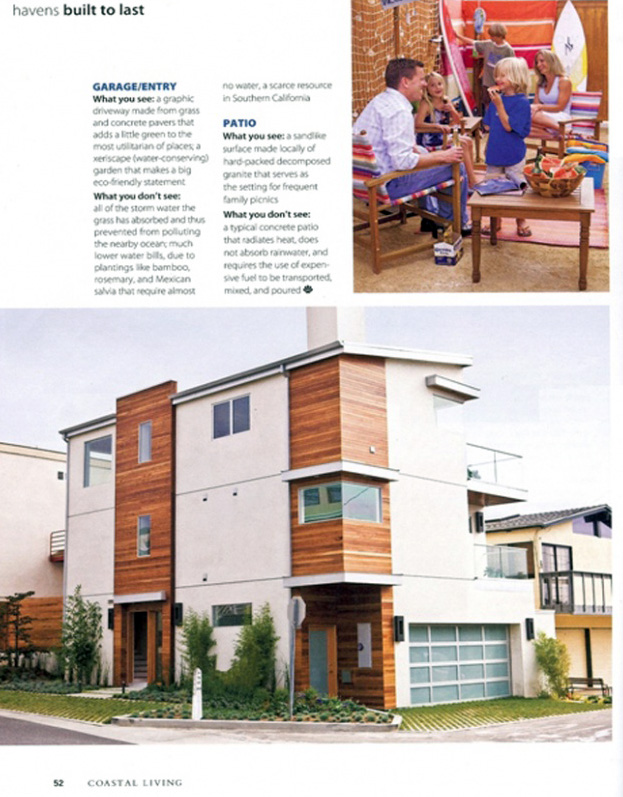Eco-Logic – Special Feature: Built to Last
May, 2009 | By Nancy A. Ruhling | Photographer Ray Kachatorian | Stylist Char Hatch Langos
Instead of tearing down their decrepit 1950s house and starting from scratch, a Manhattan Beach, California couple recycled its materials to build a new one.
Meet the Owners
When faced with the difficult choice of either razing and rebuilding their run-down 1950s Manhattan Beach house or spending far more than the ocean view property’s value on renovation costs, Dewanna and Mark Sharp took the eco-building high road: recycling more than 90 percent of the structure into an energy-efficient new home for their family, including Shane, 11, Sydney, 8 and Bradley, 6.
Their Inspiration
This pair of self-professed beach bums love Southern California for its abundant coast and year round sunshine. When the opportunity arose to build here, the couple enlisted design/build firm SoCal Contractor to create a house that fit the neighborhood and made the most of the area’s temperate climate and the lot’s Pacific view.
The Scenery
Tight rows of houses stair-step up steep hills, affording each owner an ocean view. With two miles of coastline just 20 minutes from downtown LA, Manhattan Beach is the ideal locale for outdoor enthusiast like Mark and Dewanna-who encourage their children to respect the environment- to have an eco-friendly home.
Scope of the Project
Famous Los Angeles interior designer, Lori Dennis designed the 2,500 square foot stucco and mahogany house to maximize natural light and ventilation, eliminating a need for air conditioning. Whenever possible, she used recycled or sustainable products in the construction.
Eco-Chic Choice
Dewanna and Mark opted for kitchen cabinetry made from sustainable wood (certified by the Forest Stewardship Council) with a low VOC finish that look like blown sand. It’s capped by cool gram limestone and crushed-seashell countertops.
Kitchen: What you see: a light filled room with sleek cabinetry, minimalist lighting, and contemporary hardware and fixtures-all with a modern, low profile style that doesn’t compete with the view.
What you don’t see: the already replenished wheat fields that supplied the fundamental materials for the pre-pressed wheat board barstools. Unlike wood like tea, whose harvest requires the destruction of slow growing forests, harvested wheat replaces itself quickly.
Dining Room
What you see: wrap around casement windows that take advantage of coastal breezes and make air conditioning unnecessary.
What you don’t see: improved air quality, due to Mark and Dewanna’s efforts to buy furniture –like these dining chairs- from manufacturers who utilize flat pack shipping, which helps reduce the carbon footprint by requiring fewer packing materials and less truck fuel.
Living Room
What you see: floors made from reclaimed wood that had once been used as bleacher seats in a nearby high school. “the floor are one of our favorite features,” says mark. “I have visited that high school and would like to think the wood is the same bleaches I sat on 20 years ago.”
What you don’t see: less depletion of scarce resource due to the Sharp’s choice of furnishings and accessories made from sustainable materials. The chairs and floor pillows are made from sea grass (a renewable plant that is trimmed, not killed for harvesting), the throw from organic cotton and the rug from bamboo.
Master Bedroom
What you see: a headboard made of grass roots that provides textural contrast to soft, organic cotton linens.
What you don’t see: the lack of harmful paint fumes. Throughout the house, Lori used a sandy white that has no VOCs. “All darker colors contain VOCs, “ says Dennis. “So we chose a light shade and brought in color with wood paneling instead.”
Home Eco-nomics
Cost saving way to build green at the beach. Designers, architects and builders agree that when it comes to your home the best way to protect the environment is to reuse more and waste less.
Donate Used Construction Materials like lumber, concrete and metal piping to a Habitat for Humanity ReStore, which sells the supplies at discounted rates and uses the proceeds to help fund Habitat for Humanity homes in the local community.
Incorporate Salvaged building materials into the design, like the Sharps did with the wood floors reclaimed from bleachers. Local salvage shops offer the most environmentally responsible way to do this, but companies such as Heritage Salvage provide another option.
Shop smart. Purchase furnishings and building products from eco-friendly manufacturers. Retailers such as IKEA sell items made primarily from sustainable and renewable material. Most building vendors are now offering such products as the tile made from recycled materials.
Garage/Entry
What you do see: a graphic driveway made from grass and concrete pavers that adds a little green to the most utilitarian of place, a xeriscape ( water- conserving) garden that makes an eco statement.
What you don’t see: all of the storm water the grass has absorbed and thus prevented from polluting the nearby ocean, much lower water bills, due to plantings like bamboo, rosemary, and Mexican Salvia that require almost no water, a scare resource in Southern California.
Patio
What you see: a sand like surface made of locally hard packed decomposed granite that serves as the setting for frequent family picnics.
What you don’t see: a typical concrete patio that radiates heat, does not absorb rainwater and requires the use of expensive fuel to be transported, mixed and poured.
Captions
Good design is green design. Even if you don’t use recycled materials, you can choose ones that will last and won’t have to be replaced.
Steal this idea: Give new construction depth and character with texture. A low sofa topped with a mix of throw pillows stands as a contrast to the sturdy woven side chairs a pouf, but in combination they give the impression of décor that’s been collected over time. Artwork and beach finds add a final personal touch.






